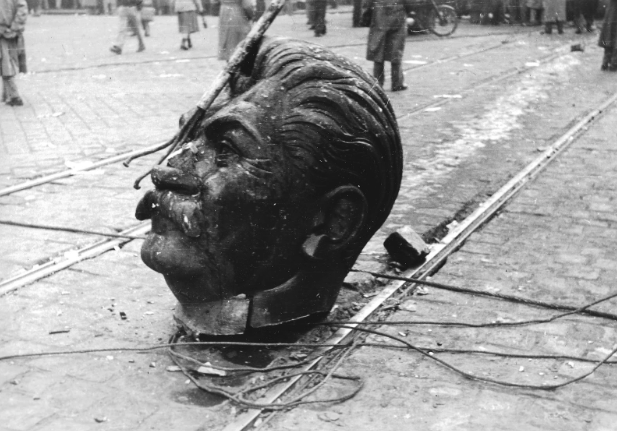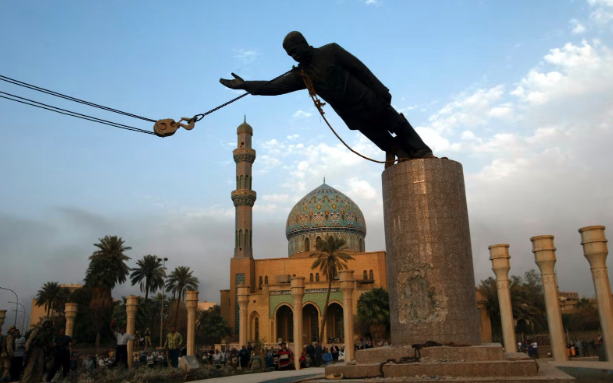A Chavez Head Dragged Through the Dirt
Yesterday, at least six statues of the Comandante Eterno were toppled by demonstrators in former chavista strongholds. This has a lot of meaning


How many times, during so many days and nights of demonstrations and blocked streets from 2002 to 2024, Hugo Chavez, Nicolas Maduro and their comrades have used men on motorcycles to intimidate or attack the population, especially protesters in middle class neighborhoods?
Profiting from a mix of class prejudice and real fear of the violent potential of a man on a motorcycle (the main vehicle for millions of working people but also of robbers and contract killers), chavismo made bikers a key part of their shock cavalry.
And now, one video runs across the world, free on the internet, with two unknown guys in Mariara, Carabobo, dragging a metal head of a toppled and beheaded statue of Hugo Chavez from a motorcycle.
Toppling statues was a part of the global iconography of contemporary revolutions. The scene of a mob taking down a formerly untouchable symbol of power and sometimes beheading it has been too powerful to not watch, and therefore too tempting to not try.
We have precedents in Venezuela: in 1878, the statues of ousted caudillo Antonio Guzman Blanco were demolished in public events; and at the beginning of this century, chavismo made a show out of the vandalization of the Columbus monument to denounce the Conquest, in the same line that many other statues have been attacked or removed during protests against racism and colonialism in a wide array of countries.
But none of those are part of the specific school of political rite that fed the visual lexicon of popular revolutions. When Hungary tried to revolt against Soviet rule in 1956, they toppled and beheaded an 8-meter-tall statue of Stalin in Budapest.
When a coup ended the first Peron government in Argentina, in 1955, many statues of the deceased wife of the leader, Evita, were destroyed and beheaded by the new regime. More recently, the domino effect that dismantled the Soviet world between 1989 and 1991 included plenty of footage about the destruction of Lenin statues, which established the pattern at the tumultuous sunset of the 20th century. When the U.S.-led military coalition invaded Iraq in 2003, a mob toppled a Saddam Hussein statue, in a heavily televised event that echoed the anti-Soviet aesthetics and reignited the symbol for new generations… and audiences. Many of us watched this in Venezuela, via CNN.
In the social media era, in a Venezuela deep into collective trauma after years of economic misery, mass migration and extreme violence, the removal of Maduro propaganda and the toppling of Chavez statues are incarnating the widespread rage against the chavista regime, the frustration of the masses about the political project that promised them a paradise, and the feeling that this time is for real: they are at the brink of collapse.
Some of the many Chavez statues erected in Venezuela were already vandalized during the 2017 uprising. Yesterday, on July 29th, at least six other statues were toppled. The first one fell in Avenida Chema Saher in Coro, Falcón state. It left an unforgettable picture (anonymous and most likely extracted from the video, in full incarnation of the times we are living) and spearheaded a viral series of attacks in former chavista strongholds: Plaza Urdaneta, Calabozo (Guárico): Avenida Carlos Soublette, La Guaira; Plaza Italia in Mariara (Carabobo); Las Tejerías (Aragua); Urbanismo El Chorrito, in Los Teques (Miranda). None of them are fancy neighborhoods, but populated areas impacted by migration, Mision Vivienda projects, industrial decline and mega gangs.
Here you can see them on this interactive map prepared by journalist Clavel Rangel, sourced by social media reports:
We were aware that hatred against Nicolas Maduro was deep and started some years ago. But that people are toppling Chavez statues, in places that were as chavista strongholds (like La Guaira), means the entire collapse of the chavista connection with Venezuelans. How do they expect to keep ruling a nation where the same people who voted for them years ago are destroying the most sacred symbols of their official imagery? How many colectivos and security officers will they need to assure governance from this day on, even if Maduro remains in charge and these protests subside?
This goes beyond the electoral landslide of July 28. That Chavez bronze head dragged across an impoverished town in central Venezuela, flashing on the screens of who knows how many smartphones abroad, shows that not only the chavista spell on people is long gone. Fear, the regime’s last and only resource, has turned into a force that exposes chavismo as an empty shell, a ruin, the debris of History.
Caracas Chronicles is 100% reader-supported.
We’ve been able to hang on for 22 years in one of the craziest media landscapes in the world. We’ve seen different media outlets in Venezuela (and abroad) closing shop, something we’re looking to avoid at all costs. Your collaboration goes a long way in helping us weather the storm.
Donate






